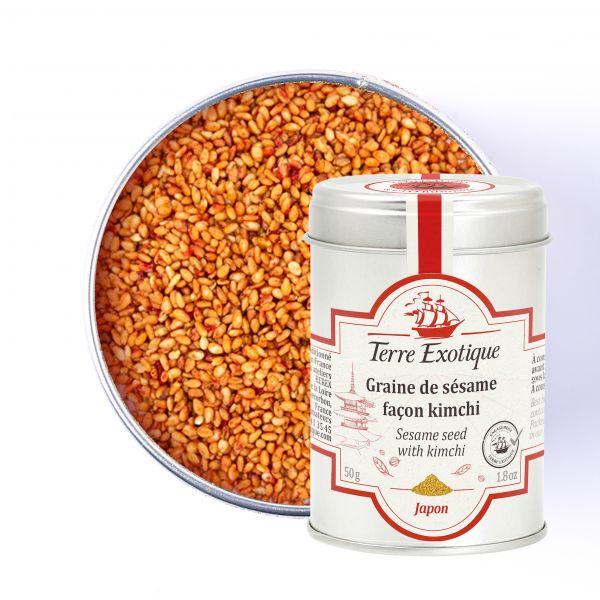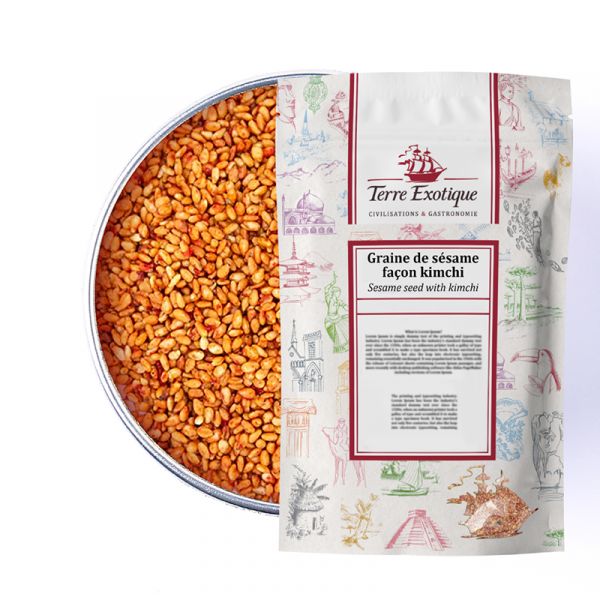





What Dishes to Use Kimchi-Flavored Sesame Seeds In?
Sesame seeds are the foundation of Asian cuisine. Flavored with kimchi, they draw inspiration from a traditional Korean dish to add a spicy flavor to your preparations.
How to Use Kimchi-Flavored Sesame Seeds in Cooking?
Our recipe ideas for using kimchi-flavored sesame seeds in your kitchen:
- Sesame-Crusted Salmon Fillet: Sprinkle both sides of your salmon fillet with kimchi-flavored sesame seeds before cooking;
- Thin Duck Skewers with Sesame: Cut your duck strips lengthwise, skewer them on skewers, then roll them in honey and finally roll them in kimchi-flavored sesame seeds before cooking;
- Sesame Zucchini: Slice your zucchinis, sauté them in a pan with a little oil and sprinkle 2 tablespoons of kimchi-flavored sesame seeds;
- Sautéed Sesame Shrimp: Sprinkle 1 tablespoon of kimchi-flavored sesame seeds on your shrimp, then sauté them with a little honey and soy sauce;
- Goat Cheese Sesame Appetizer Balls: With fresh goat cheese, form small balls and then roll them in 2 tablespoons of kimchi-flavored sesame seeds.
The Aromas of Kimchi-Flavored Sesame Seeds
Kimchi-flavored sesame seeds reveal both salty and sweet aromas. In the mouth, they offer a slight, warm spiciness that brings all its uniqueness to these seeds, ultimately giving way to a gentle flavor of roasted hazelnuts and garlic.
The Botany of Sesame Seeds
What Are Sesame Seeds?
Sesame, or Sesasmum indicum, is a plant in the Pedaliaceae family. This plant is widely cultivated in regions such as Africa or Asia for its seeds. Used raw, roasted, or ground, sesame seeds are very present in European, Asian, and American cuisine.
What Is Kimchi?
Kimchi accompanies many traditional Korean dishes. It is a preparation based on vegetables, most often cabbage, preserved in brine with some spices, including Korean chili pepper called gochugaru, which has fruity and spicy aromas, perfectly flavoring the kimchi.
In Korea, Kimchi is generally consumed cold in salads most often or to accompany a dish of white rice. Sometimes, it can be served hot, in soups, pancakes, or stews.
The taste of Kimchi is very spicy, requiring a refined palate to taste and appreciate it.
Sesame Seeds in History
Sesame seeds originated in East India. 3,000 years before Christ, the Chinese used sesame seeds as ink by transforming them into oil and then burning them to obtain a black color. Over time, sesame seeds have traversed the world to finally be used in kitchens in the form of oil, pastes, plain or flavored seeds.
| Allergen | Sésame, soja, poisson, gluten / Sesame, soy, fish, gluten |
|---|---|
| Native country | JAPON |
| Ingredients | roasted SESAME, sugar, garlic, salt, SOY sauce (including WHEAT), |
| flavour enhancers (E621,E635), protein hydrolisate, red hot pepper, | |
| colouring (paprika),BONITO extract,sweetener(stevia),acidulant(E330). | |
| Nutritional Info | VN Energie pour 100 g (energy for 100g) : 2251 kJ / 538 kcal VN Matière grasse (fat) : 43.4 g Dont acide gras saturés (of which saturated fat) : 6 g VN Glucides (carbohydrate) : 28.5 g Dont sucres (of which sugars) : 14.7 g VN Protéines (protein) : 16.5 g Vn Sel (salt) : 4 g |
| TRACES EVENTUELLES D'ALLERGÈNES | céleri, sésame, moutarde, fruits à coques. |
 Français
Français 